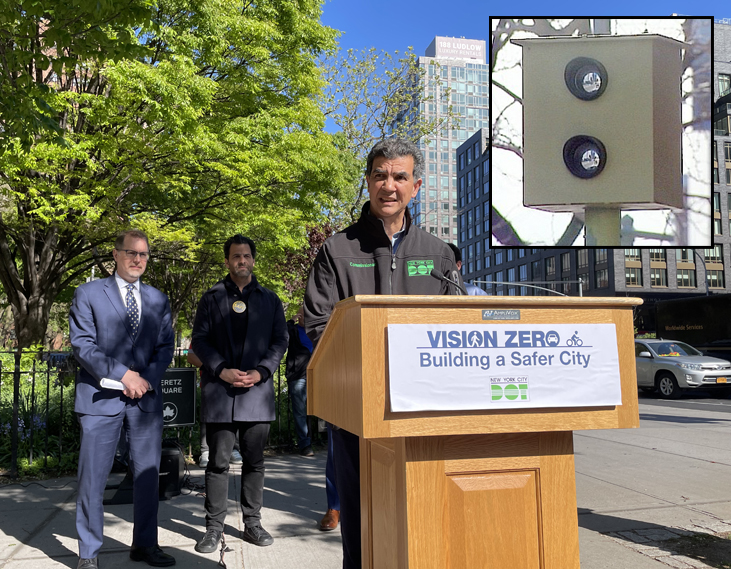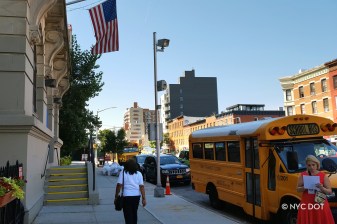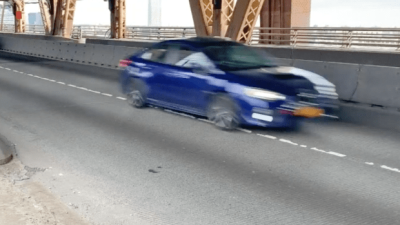Yet Another Report Makes Clear Case for City Control of Speed Cameras

In the city that doesn’t sleep, death doesn’t either.
As activists make their case in Albany for reauthorization and expansion of the city’s speed camera system, a report being issued today reiterates that 59 percent of road fatalities in the five boroughs now occur in the hours when the cameras are, by current law, unable to issue tickets.
The Transportation Alternatives’ report, “Speeding Doesn’t Sleep: Albany’s Deadly Practice of Restricting the Operating Hours of New York City’s Speed Safety Cameras,” is the latest compendium of long-known facts that bolsters advocates’ demands for full, 24-7 speed camera operation in myriad ways. The facts include:
- that speeding is a factor in roughly 80 percent of crashes with fatalities.
- that speeding drops 72 percent at locations with cameras.
- that more than half of drivers who get a camera-issued speeding ticket don’t get another one.

In addition to the report, the city Department of Transportation’s own reporting [PDF] shows that speeding returns almost immediately after cameras are turned off (a graphic, right, from its months-old report that is being distributed to lawmakers by the DOT).
The same DOT report added another statistic that shows the importance of full-day and weekend camera operation: 31 percent of all on-street traffic fatalities in the city took place in school zones that had cameras, but at times when they were not legally permitted to operate. (The DOT also revealed in March the statistic about 59 percent of deaths now occurring on weekends or overnights.)
That shortcoming explains in part why traffic fatalities remain on track to be worse than last year, which itself was the worst year for fatalities since the Vision Zero era began in 2014.
Nonetheless, legislators in Albany have not yet passed a bill, SB5602, by state Sen. Andrew Gounardes which would reauthorize the speed cameras, plus expand their use to all day, every day, instead of the current 6 a.m. to 10 p.m. on weekdays only. (Gounardes has another bill that would allow New York City to expand its red-light camera system from roughly 150 intersections to 1,325 intersections.)
Activists are getting nervous that legislators will fail to pass the bill, as they failed to pass many road safety bills last year. DOT Commissioner Ydanis Rodriguez will travel to Albany on Tuesday to lobby lawmakers personally.
“Speed safety cameras are proven to protect New Yorkers from injury and death. And, when Albany forces New York City to turn them off, their absence kills,” said Danny Harris, the executive director of Transportation Alternatives. “We need Albany to allow New York City to operate speed safety cameras 24/7 so every neighborhood is protected from speeding drivers every hour of the day, every day of the week.”
The urgency is clear. Already, at least 79 people have been killed on city streets through May 8, up from 68 over the same period last year — an increase of 16 percent. And in the past week, crashes killed 12 New Yorkers.

In anticipation of his return to Albany on Tuesday, Rodriguez rallied with Harris and other activists at the site of last week’s killing of NYU student Raife Milligan by an allegedly drunk driver. Rodriguez called for lawmakers to pass Gounardes’s bill, but also promised to make changes that he can make with his agency that don’t need Albany’s permission.
“We’re working on a bike lane here,” he said, referring to the ongoing construction of a protected bike lane on E. Houston Street east of First Avenue. “And we are working every day to change the plastic bike division to more solid ones [and] building new raised crosswalks. But again, not only for me but for the rest of the team, our crisis, the epidemic that is killing us, the blood that we have in the streets is related to reckless driving. We have to change the culture, and passing this bill is very important.”
The Gounardes bill would only reauthorize speed cameras through July 1, 2025. As a result, city officials are also hoping to convince Albany lawmakers to give New York “home rule” on the local issue of speed control. But that process is fraught, as legislators enjoy a certain amount of power over the city every few years when officials journey up the Hudson to ask for reauthorization.
“While the program is still considered a ‘demonstration’ controlled by Albany, it has long since proven the case for its permanence,” Transportation Alternatives said in a statement. “To keep people safe on New York City’s streets, our leaders need every life-saving tool available.”
Brooklyn Borough President Antonio Reynoso added a comment through TA specifically about home rule. “New York City local elected officials, including myself, have been advocating for our governor to grant us ‘home rule’ over traffic laws. This would allow us to take the right steps, implement necessary safety measures, and keep our streets safe,” he said.
Gov. Hochul seemed clear on Friday that she’s open to giving local officials power to run local initiatives such as speed cameras.
Attending the fabulous @RegionalPlan 100th anniversary Assembly. @GovKathyHochul just gave an endorsement to home rule for red light and speed camera enforcement in #NYC!! #safestreets @NYC_SafeStreets @TransAlt
— Felicia Park-Rogers (@FPRinBklyn) May 6, 2022
Polls show that New York City residents overwhelmingly support speed cameras, which only kick in when a person is driving in a school zone at least 11 miles per hour above the posted speed limit. And in a 2021 survey commissioned by Open Plans and conducted by Data for Progress, 65 percent of respondents agreed with the statement that drivers must slow down, while only 12 percent said that they did not need to.
— with Dave Colon




